Tour de France jerseys: Yellow, green, white and polka dot explained
We explain what the yellow, green, polka dot and white jerseys worn by riders in the Tour de France represent
- Sign up to our newsletter Newsletter
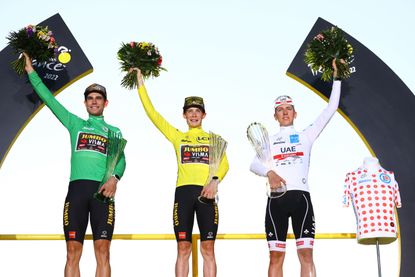
- Yellow jersey
- Green jersey
- Polka dot jersey
- White jersey
- Other classifications

The Tour de France sees the very best cyclists in the world battle it out for the yellow, green, white and polka dot jerseys, based on the general, points, mountains and young rider classifications.
The jersey for each category is awarded to the leader of that classification at the end of every stage, and the recipient earns the right to wear it during the following day's racing. When a rider has the lead in multiple classifications, the yellow jersey is prioritised, then green, the polka dot, and white - the next person on the ranking wears the kit in the leader's stead.
Here we take a brief look at what they are and how they are won.


Tour de France yellow jersey - GC leader
Also called the maillot jaune , the Tour de France yellow jersey is the most coveted piece of kit in professional cycling. The wearer is the rider who has completed the race in the least amount of time, and as such tops the overall or general classification (GC) of the race.
Tadej Pogačar (UAE Team Emirates) dominated the GC in 2020 and 2021, wearing the yellow jersey almost throughout the 2021 edition, before Jonas Vingegaard (Jumbo-Visma) took it off him halfway through the 2022 race, wearing it until the end of the race.
Before that, in 2012, Bradley Wiggins became the first British rider to finish in Paris in the Yellow Jersey - with Chris Froome following up in 2013, 2015-2017. Geraint Thomas took the 2018 race, becoming the third British rider to win the race.
The yellow jersey is sponsored by LCL, a French bank, and it is yellow, because the Tour's original organiser, L'Auto , was a newspaper printed on yellow paper.
Get The Leadout Newsletter
The latest race content, interviews, features, reviews and expert buying guides, direct to your inbox!
A time bonus of 10, six and four seconds will be awarded to the first three riders across the finish line each day (not including TTs). These bonus seconds are taken off their stage and therefore overall time. Bonus seconds of eight, five and two seconds are also awarded on certain, strategically placed climbs on stages one, two, five, 12, 14 and 17.
Last 10 winners of the Tour de France general classification:
- 2013: Chris Froome
- 2014: Vincenzo Nibali
- 2015: Chris Froome
- 2016: Chris Froome
- 2017: Chris Froome
- 2018: Geraint Thomas
- 2019: Egan Bernal
- 2020: Tadej Pogačar
- 2021: Tadej Pogačar
- 2022: Jonas Vinegaard
Tour de France green jersey - points classification
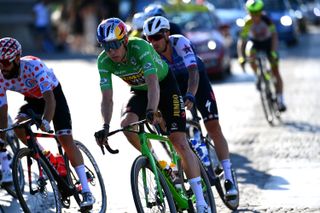
The green jersey relates to points awarded to riders according to the position they finish on each stage, with additional points for intermediate sprints during some stages also on offer.
The number of points on offer will vary depending upon the type of stage. More are on offer during pure flat, sprint days, while on hilly and mountain stages there are fewer points available. The points are then tallied up after each stage and added to points won in all previous stages. The green jersey ( maillot vert) is awarded to the rider with the most points. Sometimes it is a sprinter's game, sometimes more of an all-rounder - like Wout van Aert (Jumbo-Visma).
The jersey took its colour because the initial sponsor was a lawn mower manufacturer - though the colour was changed once in 1968 to accommodate a sponsor. It is now sponsored by Škoda, and has a new shade for this year .
Both Eddy Merckx and Bernard Hinault successfully won both the general classification and the points classification with Merckx achieving the biggest sweep in 1969 with the points, mountain and general classifications to his name. Over the last ten years, Peter Sagan has triumphed in the points classification on no less than seven occasions.
The following points are on offer:
Flat stage (stages 2, 3, 4, 7, 8, 11, 18, 19, 21): 50, 30, 20 points (descending to 15th place)
Hilly stage (stages 1, 9, 10, 12, 13): 30, 25, 22 points (descending to 15th place)
Mountain stage and ITTs (5, 6, 14, 15, 16, 17, 20): 20, 17, 15, (descending to 15th place)
Intermediate sprint: 20, 17, 15, (descending to 15th place)
Last 10 winners of the Tour de France points classification:
- 2013: Peter Sagan
- 2014: Peter Sagan
- 2015: Peter Sagan
- 2016: Peter Sagan
- 2017: Michael Matthews
- 2018: Peter Sagan
- 2019: Peter Sagan
- 2020: Sam Bennett
- 2021: Mark Cavendish
- 2022: Wout van Aert
Tour de France jerseys: Polka dot - King of the Mountains classification leader
Tour de france polka dot jersey - mountains classification.
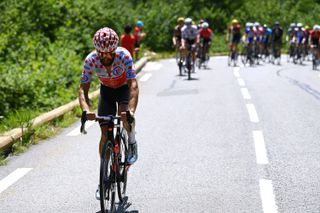
Mountains points are awarded to riders who manage to summit classified climbs first. Points vary depending on the category of each ascent, with more difficult climbs awarding more mountains points.
Climbs are divided into five categories: 1 (most difficult) to 4 (least difficult) - then there's the ' Hors Categorie ', denoted by HC which represents the most challenging of ascents. The tougher the category, the more points on offer, and to more riders - a HC climb will see points awarded down to the first eight over the summit, while a fourth category climb results in points for just the first rider over the top.
The organisers decide which mountains or climbs will be included in the competition, and which category they fall into. If the stage features a summit finish, the points for the climb are doubled.
The points are tallied up after each stage and added to points won in all previous stages. The distinctive white-with-red-dots jersey ( maillot à pois rouges ) is given to the rider with the most mountains points. The first climber's award was given out in 1933, and the jersey arrived on the scene in 1975. It is now sponsored by Leclerc, a supermarket.
Points awarded as follows:
HC: 20, 15, 12, 10, 8, 6, 4, 2pts
1st cat: 10, 8, 6, 7, 5, 1pt
2nd cat: Five, three, two.
3rd cat: Two and one points
4th cat: One point
The souvenir Henri Desgrange is awarded to the first rider over the race’s highest point, the Col de Loze, on stage 17. The souvenir Jacques Goddet to the first rider over the Col du Tourmalet on stage 16.
Last 10 winners of the Tour de France mountains classification:
- 2013: Nairo Quintana
- 2014: Rafał Majka
- 2015: Chris Froome
- 2016: Rafał Majka
- 2017: Warren Barguil
- 2018: Julian Alaphilippe
- 2019: Romain Bardet
Tour de France white jersey - best young rider

The plain white, young rider classification jersey is awarded to the fastest rider born after 1 January 1998, meaning 25 or under. It is sponsored by Krys, an opticians
First introduced in 1975, riders such as Marco Pantani, Alberto Contador, Egan Bernal and Tadej Pogačar have all won the young rider classification, helping propel them onto bigger and better things during their careers.
Last 10 winners of the Tour de France young rider classification:
- 2014: Thibaut Pinot
- 2015: Nairo Quintana
- 2016: Adam Yates
- 2017: Simon Yates
- 2018: Pierre Latour
- 2022: Tadej Pogačar
Other Tour de France classifications - team and combativity
There are two further classifications that do not earn the winner(s) a coloured jersey - the most aggressive rider award and Team Classification .
While not necessarily a classification, the Combativity Award is given to the rider who has shown the most fighting spirit during each individual stage, as chosen by the race jury. They will wear a gold race number during the following day's stage. A 'Super Combativity' award is handed out on the final stage for the most aggressive rider during the whole race.
The Team Classification is based on the collective time of the three highest-placed riders from each squad. Leaders of the team classification get to wear race numbers that are yellow with black digits, and the right to wear yellow helmets. The latter is not compulsory.
Thank you for reading 20 articles this month* Join now for unlimited access
Enjoy your first month for just £1 / $1 / €1
*Read 5 free articles per month without a subscription
Join now for unlimited access
Try first month for just £1 / $1 / €1
Adam is Cycling Weekly ’s news editor – his greatest love is road racing but as long as he is cycling on tarmac, he's happy. Before joining Cycling Weekly he spent two years writing for Procycling, where he interviewed riders and wrote about racing. He's usually out and about on the roads of Bristol and its surrounds. Before cycling took over his professional life, he covered ecclesiastical matters at the world’s largest Anglican newspaper and politics at Business Insider. Don't ask how that is related to cycling.

Joe Blackmore set to make the step up to Israel-PremierTech ProTeam from the Academy next season
By James Shrubsall Published 15 April 24

Knee pain is common among cyclists - we explain some of the causes and how to address them with help from a coach, bike fitter and osteopath
By Michelle Arthurs-Brennan Published 15 April 24
Useful links
- Tour de France
- Giro d'Italia
- Vuelta a España
Buyer's Guides
- Best road bikes
- Best gravel bikes
- Best smart turbo trainers
- Best cycling computers
- Editor's Choice
- Bike Reviews
- Component Reviews
- Clothing Reviews
- Contact Future's experts
- Terms and conditions
- Privacy policy
- Cookies policy
- Advertise with us
Cycling Weekly is part of Future plc, an international media group and leading digital publisher. Visit our corporate site . © Future Publishing Limited Quay House, The Ambury, Bath BA1 1UA. All rights reserved. England and Wales company registration number 2008885.
- As it happened: Marianne Vos wins Amstel Gold Race women with bike throw on the line
- As it happened: Pidcock wins Amstel Gold Race
The jerseys of the 2024 Tour de France
Details of the four iconic leader's jerseys and the minor prizes at the race
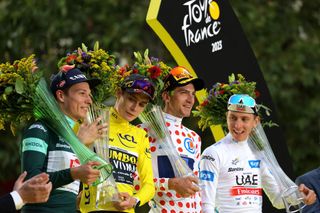
There are four Tour de France classification jerseys awarded after every stage of the three-week race, each recognising different successes and talents in the race.
The iconic yellow jersey is worn by the race leader based on time, the green jersey is awarded to the leader based on points awarded at intermediate sprints and the finishes, the red polka-dot king of the mountains jersey is based on points awarded on categorised climbs, while the white best young rider's jersey is another based on time, only reserved for riders born after January 1, 1998.
The team classification is also based on time, with the riders of the leading team racing with special yellow numbers (dossards). The most aggressive rider wears a special gold number during the following stage.
The most aggressive rider (super-combatif) of the whole race is selected by members of the jury at the end of the Tour de France and is awarded a trophy on the final podium in Paris just like the other competition winners.
Santini is the official jersey maker for the Tour de France, and will put the finishing touches - adding all necessary logos - to the winners' jerseys on-site at the Tour de France. That also means fans can buy their own replica jerseys and other Tour de France merchandising.
The yellow jersey – the maillot jaune

The yellow jersey is worn by the leader of the general classification, the rider with the lowest net time in the race after every stage. The rider who takes it to Paris is crowned the Tour de France winner, the most prestigious success of the men’s cycling season.
Jonas Vingegaard (Jumbo-Visma) won the 2022 and 2023 Tour de France.
Get The Leadout Newsletter
The latest race content, interviews, features, reviews and expert buying guides, direct to your inbox!
The jersey is yellow because the newspaper that first organised the race, L'Auto , was printed on yellow paper.
The classification is based on the time taken for each rider to cover the 21 stages, taking into account time penalties and time bonuses.
In the event of a tie in the general classification, the hundredths of a second recorded by the timekeepers during the individual time trial stages will be included in the total times in order to decide the overall winner.
In the absence of a time trial or if the riders remain tied, then the positions in which they finished each stage will be added up and, as a last resort, their finishing position on the final stage will be taken into account.
Bonus seconds are offered to encourage attacking racing and these are deducted from the time taken to cover the stage. Bonuses of 10, 6, and 4 seconds are awarded on the finish line to the leading three riders on each stage, excluding time trials. There are also certain climbs with bonuses of 8, 5, and 2 seconds at the top such as the Jaizkibel on stage 2 which should encourage aggressive riding from the favourites.
All riders must finish within the time limit – a certain percentage (ranging from 104% to 120% depending on the stage and average speed) of the stage winner's time each day in order to continue in the race. This is often a problem for sprinters, domestiques and injured riders when it comes to the high mountains.
The green jersey – the maillot vert
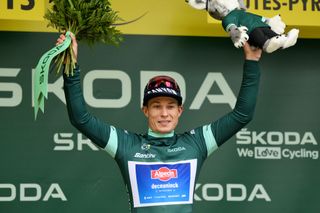
The green jersey is worn by the leader of the points classification. Points are awarded at stage finishes and intermediate sprints.
While the sprinters are the main candidates for the green jersey, it's the more versatile among them who have the best chance of overall success in Paris.
Peter Sagan is one such rider and has won green in seven of the past nine Tours, while Wout Van Aert dominated the points classification in 2022 to take his first green jersey. Jasper Philipsen won four sprint stages to anchor his green jersey in 2023.
Points are awarded to the first 15 riders at stage finishes or intermediate sprints, with different allocations depending on the nature of the stage. More points are awarded on flat stages than on mountain stages or time trials. The winner of a flat stage scores 50 points, a mountain stage winner just 20.
Only riders who complete the entire Tour de France are included in the points classification.
In the event where a rider or riders finish outside the time limit but are reinstated by the president of the commissaires’ jury, they will lose all points awarded to them in the points classification.
For 2023 the green jersey was a much darker shade of green than fans are used to as per a request made by the sponsor of the jersey, Skoda but the colour was not popular with fans.
The polka-dot jersey – the maillot blanc à pois rouges
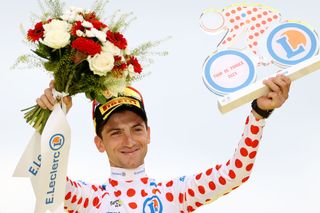
The polka-dot jersey is worn by the leader of the mountains classification, who is known as the 'king of the mountains.’ For the three recent editions of the Tour, the overall winner has also won the polka-dot jersey but Italy's Giulio Ciccone of Lidl-Trek won the competition in 2023.
Mountain points are on offer at the top of every classified climb, ranging from the hardest – 'hors catégorie' – to the easiest – category 4.
Hors catégorie: 20-15-12-10-8-6-4-2
Category 1: 10-8-6-4-2-1
Category 2: 5-3-2-1
Category 3: 2-1
Category 4: 1
In the event of two riders being equal on points, the rider with the most first places at the summit of super-category passes or climbs or summit finishes will be declared the winner.
Only riders who complete the entire Tour de France will be included in the best climber classification. In the event of a rider or riders finishing outside the time limit but being reinstated by the president of the commissaires’ jury, they will lose all points awarded to them in the best climber classification.
The white jersey – the maillot blanc

The white jersey is worn by the leader of the youth classification.
A 'young rider' is anyone who was born after January 1, 1998, so anyone under 25. The jersey goes to the best placed on general classification, based on time.
Tadej Pogačar has won the white jersey at the last four editions of the Tour, two of which he also won the yellow jersey.
The white jersey often used to be an indication of future Tour de France contenders, but since Pogačar has risen to greatness at such a young age, it's been difficult to see the future contenders as obviously. He is now too old for competition, with the white jersey up for grabs in 2024.
The gold dossard
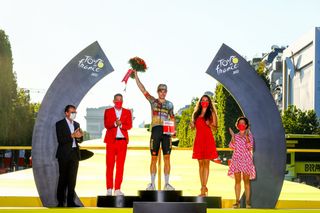
The special gold number dossard is awarded to the rider deemed, subjectively, the ‘most combative’ the previous day. It is usually the rider most active in the breakaway or someone who shows panache and aggression or even qualities of sportsmanship. It used to be a red number, but has changed this year as Century 21 now sponsor the classification and the new colour runs in line with their branding.
The prize, which is awarded on every road stage except the final one, is decided by a jury presided over by the race director and a new vote made by members of the Tour de France Club. Each stage’s most aggressive rider wears a gold race dossard during the following stage.
The race’s most aggressive rider (super-combatif) is selected by members of the jury at the end of the Tour de France and was won by Wout Van Aert in 2022. This year Victor Campenaerts (Lotto Dstny) won the super-combatif award after a number of aggressive attacks on stages.
Yellow dossard

The yellow race number dossard is worn by members of the team leading the teams classification. It is calculated by adding together the times of each team's three best riders on every stage.
Any team reduced to fewer than three riders will be eliminated from the team classification.
Wearing a leader’s jersey is mandatory from the signing-in protocol before the stage start until the post-stage press conference.
Skinsuits are provided to the leaders of the various rankings for time trial stages, with special fitting sessions arranged the day before the time trials.
Riders can lead multiple jersey classifications but only wear one jersey in the race. There is an established order of priority for the different leader’s jerseys: the yellow jersey, followed by the green jersey, then the red polka-dot jersey and finally the white jersey.
When a rider is leading several classifications, they wear the one designated by the order of priority. The other jerseys are then worn by the riders lying second, third or fourth in the corresponding classification.

Stephen is the most experienced member of the Cyclingnews team, having reported on professional cycling since 1994. He has been Head of News at Cyclingnews since 2022, before which he held the position of European editor since 2012 and previously worked for Reuters , Shift Active Media , and CyclingWeekly , among other publications.
Ardennes Classics - Could SD Worx's distraction over Demi Vollering's future prevent a triple crown repeat?
Ashlin Barry pursues family racing tradition, 2028 Olympics already a goal
‘I had to gamble’ – Mathieu van der Poel’s winning run broken at Amstel Gold Race
Most Popular
Here’s Exactly What the Tour de France Jersey Colors Mean
The story behind the yellow, green, polka dot, and white shirts.
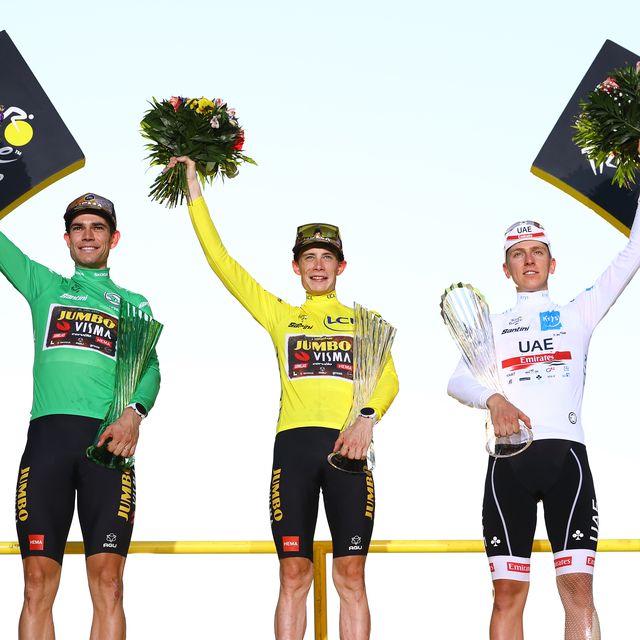
Here’s a simple breakdown of what each Tour de France jersey color means:
Yellow Jersey
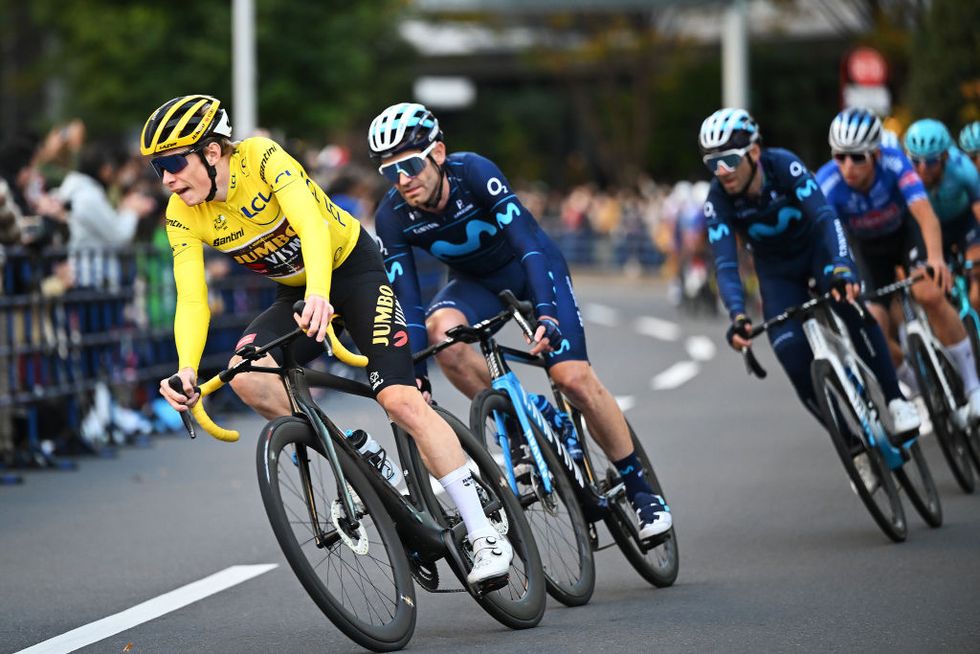
For most, the race’s fabled yellow jersey, or maillot jaune, stands above all else, as it designates the rider who leads the General Classification . After each stage, officials calculate who has the fastest time across the entire race and the jersey then goes to the overall leader. That rider wears it in the following stage. Because it’s based on time and not points, the yellow doesn’t necessarily go to the given day’s stage winner, but rather the leader overall.
Contenders for the yellow jersey—and, therefore, the overall Tour de France title—are well-rounded cyclists and smart tacticians with skills in both climbing and time trialling. They must also show enough strength to hold the pace of the peloton, especially as rival teams work together to drop the leader at every possible opportunity.
Here's how the Tour’s yellow jersey gets made during the race:
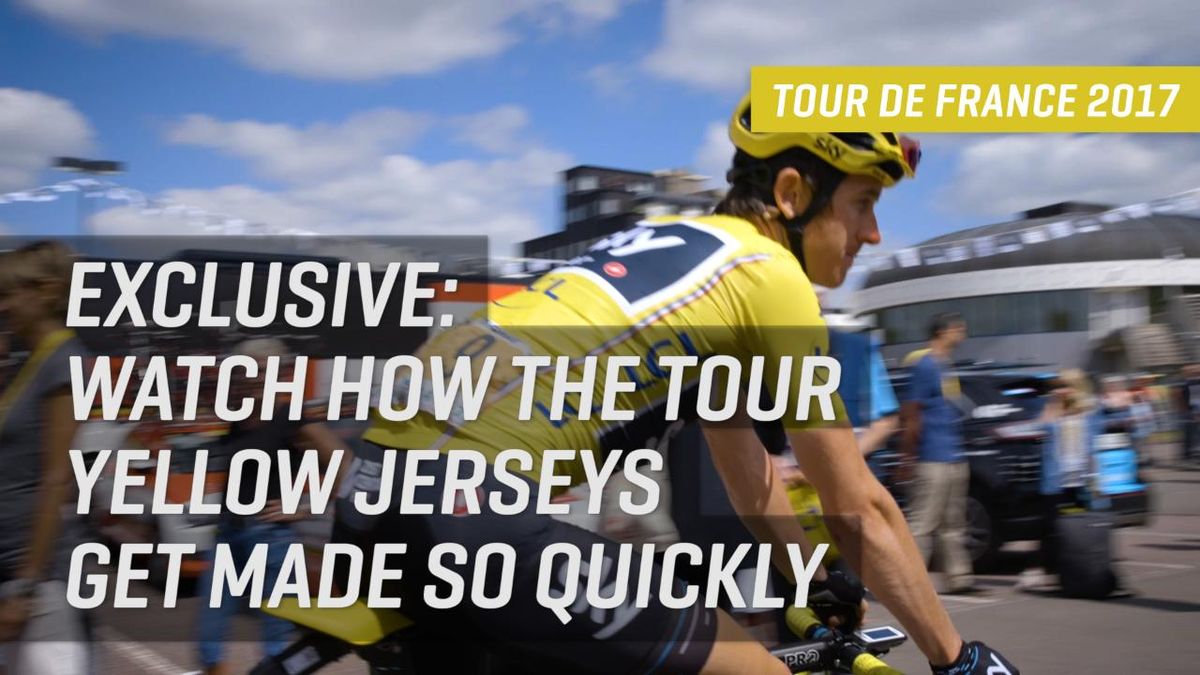
Green Jersey
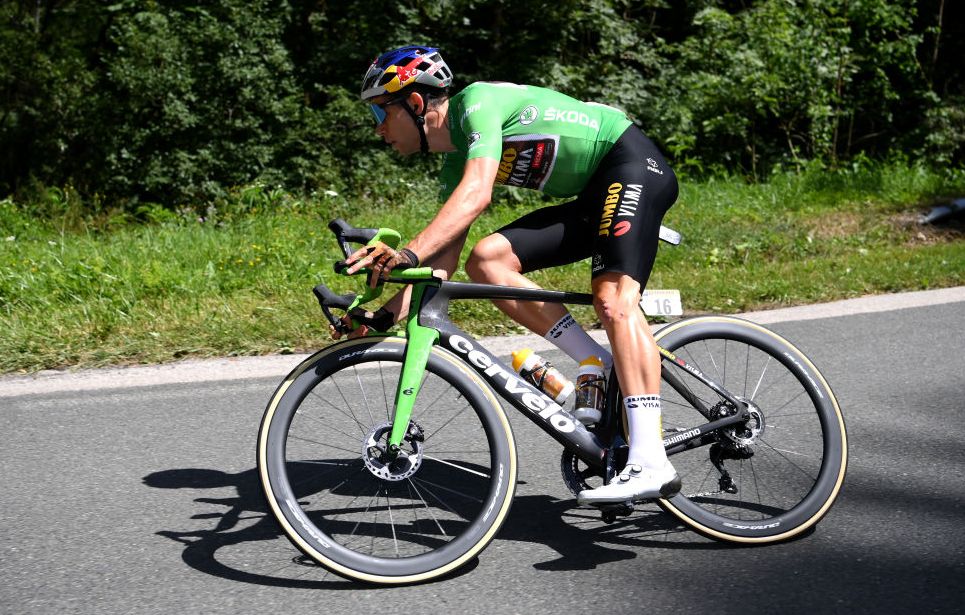
While known as the “sprinter’s jersey,” the green jersey goes to the leader of the Points Classification . The amount of points given depends on the stage profile—whether it’s flat or mountainous, for example. Typically, the winners are the first 10 to 25 riders who cross a stage finish, because the most points are traditionally gained at the end of the flatter stages (where the sprinters shine).
Ultimately, the green goes to a well-rounded and consistent rider, as well as to those who show tremendous persistence, picking up points where they can.
Red Polka Dot Jersey
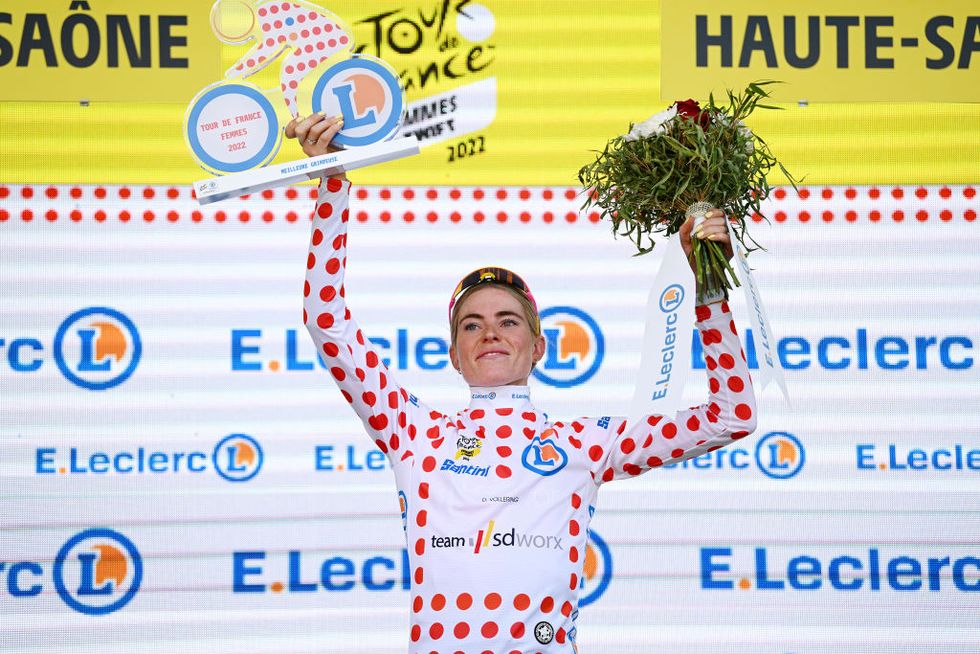
The polka dot jersey goes to the leader of the Mountains Classification , otherwise known as King of the Mountains. Points in this contest are awarded to the first riders who reach the summit of designated climbs on each stage.
Tour de France climbs are ranked from category 1 (most difficult) to category 4 (least difficult). A fifth class, hors catégorie (“beyond category”), is reserved for the most challenging ascents. The amount of points awarded depends on the difficulty of each climb, though sometimes shorter or milder climbs will join a higher category if they come at the end of a stage.
Of course, the rider in polka dots must be a strong climber. Often, it goes to small, lightweight guys with very high power outputs . The KoM competition comes into its own once the race heads into the mountain stages, where most points are available.
White Jersey
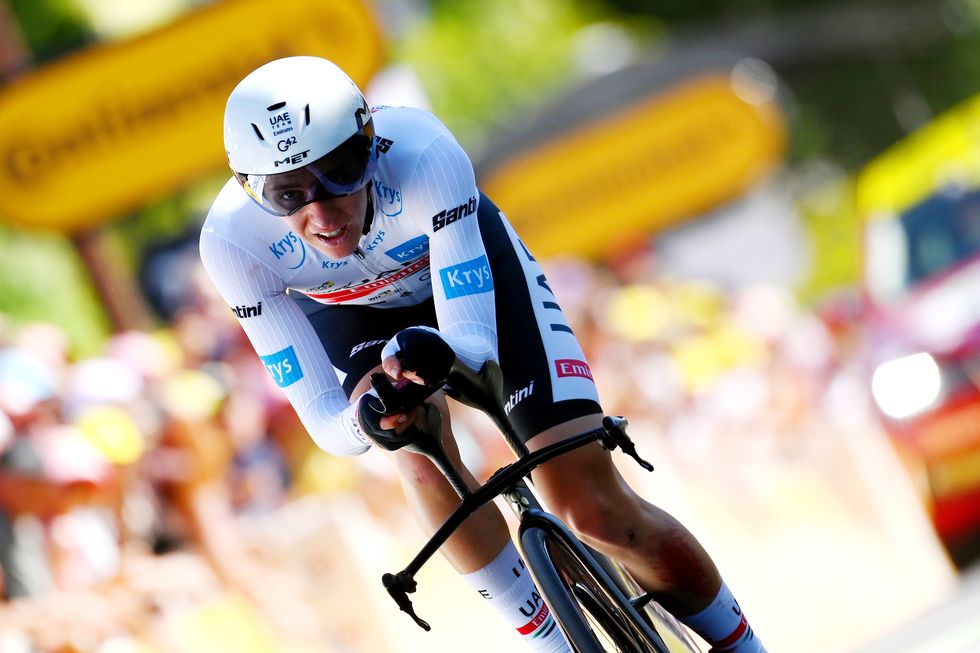
The white jersey, or maillot blanc , goes to the General Classification leader who is 25 years old or younger (on January 1 in the given race year). Put simply, it goes to the best young rider with the lowest overall time. For young, ambitious all-rounders in the race, winning the white jersey is like winning yellow.
Other Awards
Two other classifications exist that are not awarded with a special jersey: the Combativity Award and the Team Classification.
Although largely a token prize, Combativity Award winners still get a podium appearance when the race wraps up in Paris. After every stage, excluding time trials, a panel decides the day’s most aggressive rider. Not necessarily the stage winner, it could be someone who has consistently attacked, instigated a breakaway , or been a key player in the stage outcome. This rider then wears a red race number (instead of black) in the following day’s stage. A Super Combativity Award is given on the final stage for the most aggressive rider throughout the entire Tour.
The Team Classification is based on the collective time of the three highest-placed riders in the General Classification from each team. The best team then wears its race numbers against a yellow background, rather than a conventional white background, and also has the option of wearing yellow helmets.
.css-1t6om3g:before{width:1.75rem;height:1.75rem;margin:0 0.625rem -0.125rem 0;content:'';display:inline-block;-webkit-background-size:1.25rem;background-size:1.25rem;background-color:#F8D811;color:#000;background-repeat:no-repeat;-webkit-background-position:center;background-position:center;}.loaded .css-1t6om3g:before{background-image:url(/_assets/design-tokens/bicycling/static/images/chevron-design-element.c42d609.svg);} 2024 Tour de France Femmes avec Zwift
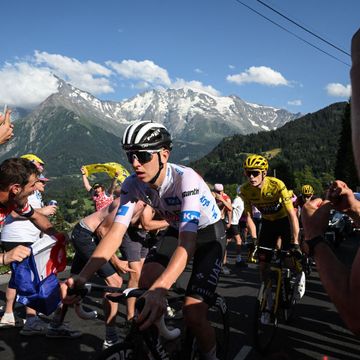
Should We Worry About the Tour de France Femmes?
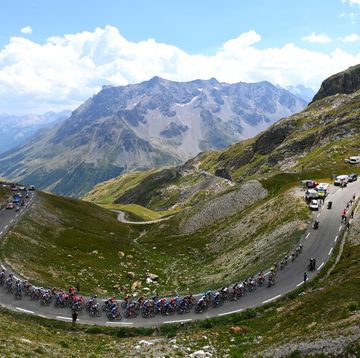
2024 Tour de France May Start Using Drones

Riders Weigh In on the Tour de France Routes
Tour de France

How Fast Do the Pros Ride in the Tour de France?

Challengers of the 2024 Giro d'Italia and TdF
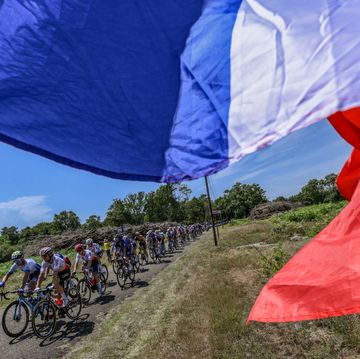
The 2024 Tour de France Can’t Miss Stages
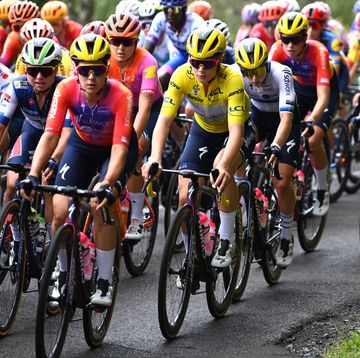
2024 Tour de France Femmes Can't-Miss Stages
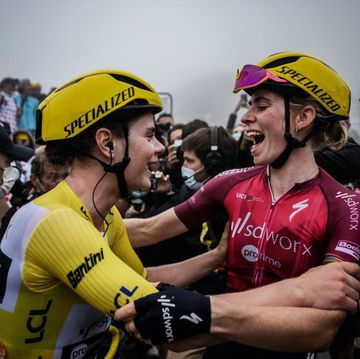
How Much Money Do Top Tour de France Teams Make?

2024 Tour de France/ Tour de France Femmes Routes
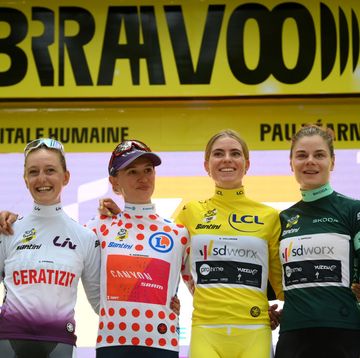
How Much Did Tour de France Femmes Riders Earn?
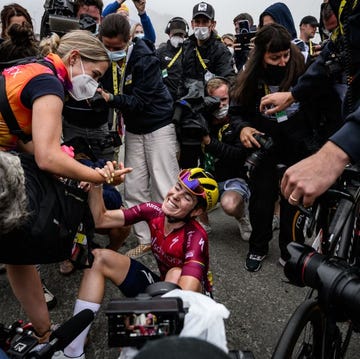
5 Takeaways from the Tour de France Femmes
Official games

2023 Edition
- Stage winners
- All the videos
Tour Culture
- Commitments
- key figures
- Sporting Stakes
- "Maillot Jaune" Collection
- The jerseys

YELLOW JERSEY

The symbol of the Tour de France, the yellow jersey , sponsored by LCL, is worn every day by the leader of the general individual classification and bestowed on the overall winner on the Champs-Élysées. A symbol of excellence, prestige and victory, the yellow jersey is beyond the reach of all but the most well-rounded riders —those who can hold their own on the plains, in the mountains and in time trials.

Accreditations
Privacy policy, your gdpr rights.
- Race Previews
- Race Reports
- Race Photos
- Tips & Reviews
Riders to Look Out for at Dwars Door Vlaanderen Men in 2024
Lorena wiebes secures hard-fought victory at gent-wevelgem women’s race, mads pedersen edges out mathieu van der poel in epic gent-wevelgem duel, live: 2024 women’s gent wevelgem, women’s dwars door vlaanderen 2024 race preview.

Email: [email protected]
The Ultimate Guide to the Iconic Jerseys of Tour de France
Mathew Mitchell
- Published on June 29, 2023
- in Men's Cycling
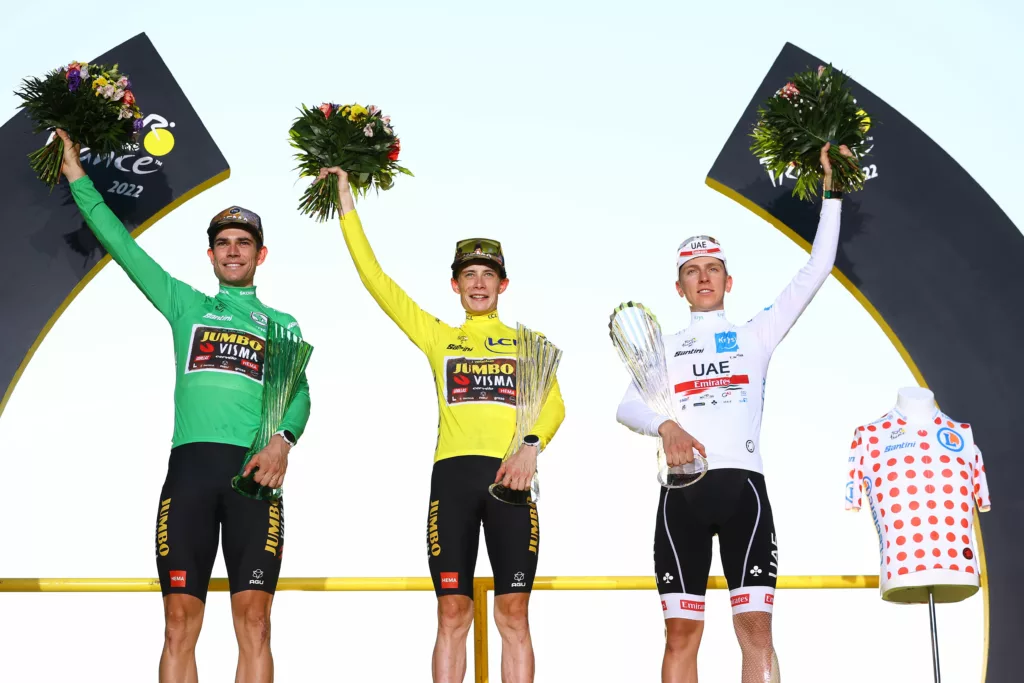
Step into the world of Tour de France and be mesmerised by the kaleidoscope of colours and symbolism that grace the iconic jerseys worn by the pro peloton. In this ultimate guide, we take you on a journey through the rich history and captivating stories behind these renowned garments. From the infamous yellow jersey that symbolises the leader of the race, to the polka dot jersey representing the best climber, each jersey carries its own unique narrative.
Table of Contents
Discover the secrets behind the green jersey, awarded to the best sprinter, and the white jersey, honouring the best young rider. Unveiling the intricate details and design choices, we delve into the significance of every stripe, dot, and patch. Whether you’re a fan of cycling or simply intrigued by the world of sports fashion, this guide will leave you with a newfound appreciation for the artistry and symbolism woven into the fabric of the Tour de France jerseys. So gear up and embark on this captivating journey through the vibrant world of cycling attire.
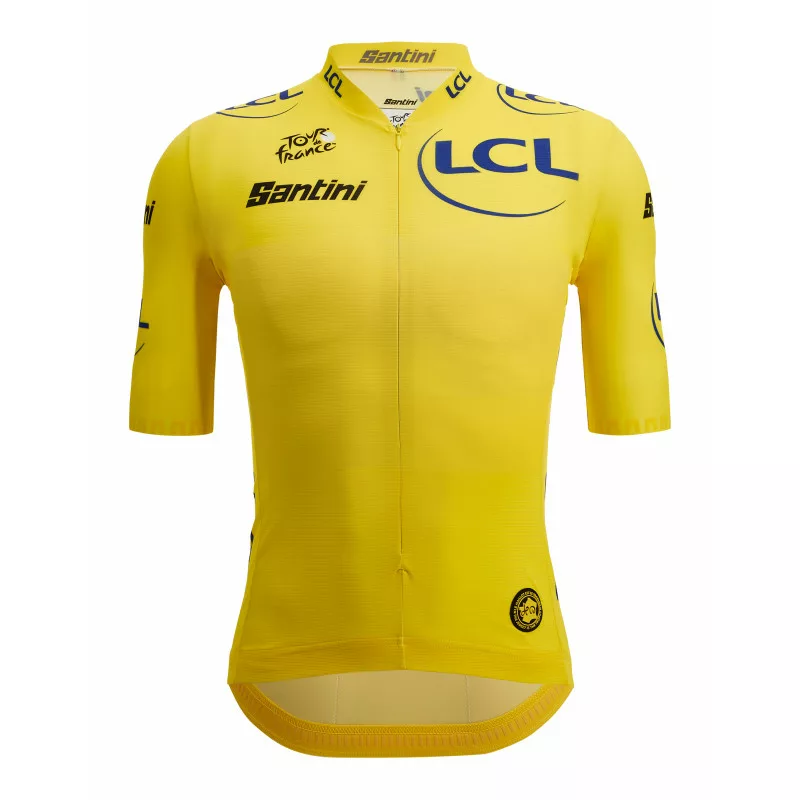
The yellow jersey: Maillot Jaune – The leader’s jersey
The yellow jersey , or Maillot Jaune, is undoubtedly the most iconic and coveted jersey in the Tour de France. Worn by the overall leader of the race, it signifies their dominance and command over the peloton. The history of the yellow jersey dates back to 1919 when it was introduced as a way to easily identify the race leader. The colour yellow was chosen due to its close association with the yellow paper used by the organising newspaper, L’Auto, which later on became L’Équipe.
The yellow jersey is not just a symbol of leadership; it also represents the determination, endurance, and sheer willpower required to succeed in the gruelling race. The jersey’s design has evolved over the years, but its distinctive yellow hue remains a constant. From the classic golden shade to the vibrant lemon yellow, each iteration of the jersey has left an indelible mark on the history of the Tour de France. Similar to the All Blacks in rugby, a simple jersey has come to represent something much bigger.
The yellow jersey is not only a badge of honour but also a target for other competitors. Riders will fight tooth and nail to seize the coveted jersey, resulting in intense battles throughout the race. It is this relentless pursuit of the yellow jersey that adds an extra layer of excitement to the Tour de France, making it one of the most anticipated and thrilling sporting events in the world.
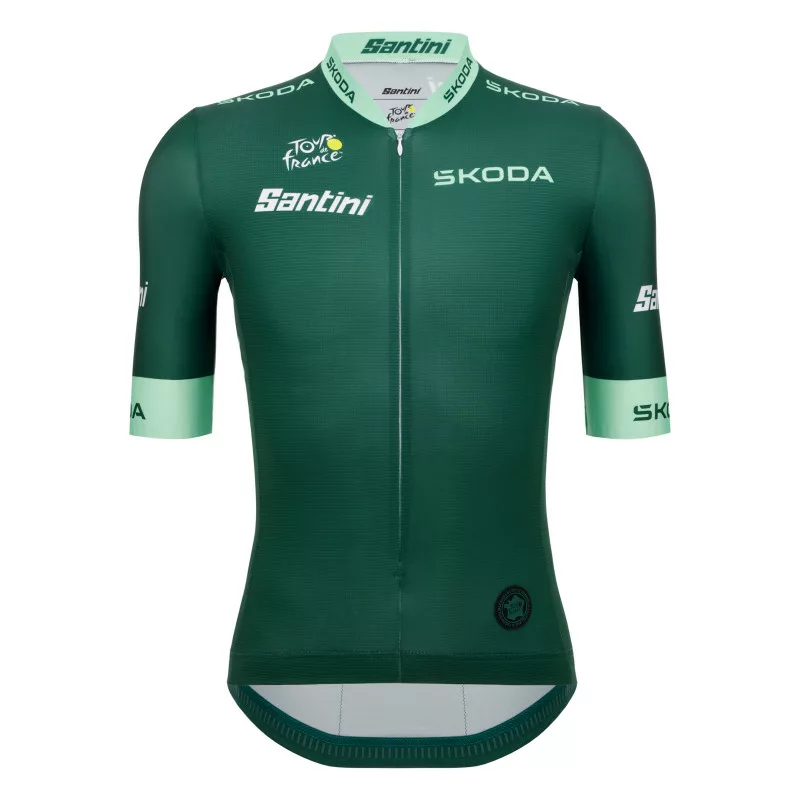
The green jersey: Maillot Vert – The sprinter’s jersey
While the yellow jersey represents the overall leader, the green jersey, or Maillot Vert, is awarded to the best sprinter in the Tour de France. This jersey recognises the riders who excel in the flat stages and possess exceptional speed and strength. It’s not just about flat stages though, increasingly the winner has had to do well on hills. The green jersey was first introduced in 1953 to add another dimension to the race and reward the sprinters for their unique skills.
The green jersey stands out from the crowd with its vibrant shade of green, often referred to as “sprinters’ green.” The colour was chosen to symbolise the lushness and energy associated with sprinting. The design of the jersey features various sponsors’ logos, contributing to its dynamic and eye-catching appearance. Fans of a certain age will remember PMU’s logos on it but for the 2023 Tour de France, Skoda will have their logo on the green jersey.
Winning the green jersey requires consistent performance across the flat stages, where the sprinters have the opportunity to showcase their explosive power. Points are awarded at intermediate sprints and the finish line, with the rider amassing the most points throughout the race being crowned the winner of the green jersey. The battle for the green jersey adds an extra layer of excitement to the Tour de France, as riders push themselves to the limit in thrilling sprint finishes.
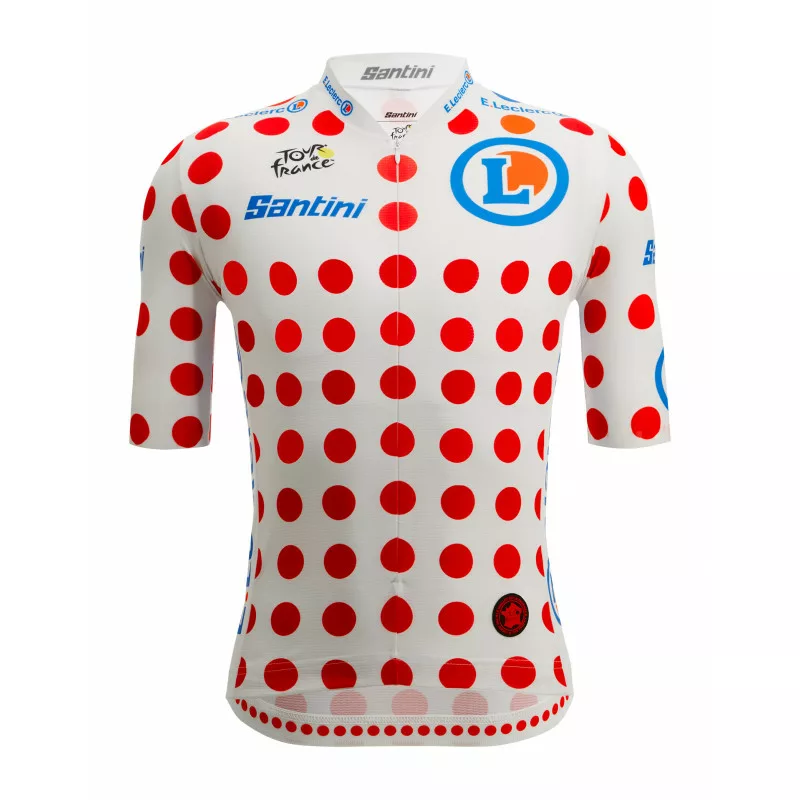
The polka dot jersey: Maillot à Pois – The King of the Mountains jersey
The polka dot jersey, or Maillot à Pois, is one of the most visually striking jerseys in the Tour de France. It is awarded to the rider who excels in the mountain stages, conquering the challenging ascents and demonstrating exceptional climbing abilities. Introduced in 1975, the polka dot jersey adds a touch of drama to the race, highlighting the fierce battles that take place in the mountains. Despite being a relatively recent addition as a jersey, there has been a form of a mountains classification since 1905.
The polka dot jersey gets its name from the distinctive polka dot pattern adorning the jersey. The design was inspired by the red and white polka dot jersey worn by the best climber in the 1969 Vuelta a España, which caught the attention of the Tour de France organisers. The dots represent the mountains and the relentless effort required to conquer them.
To win the polka dot jersey, riders must accumulate points by reaching the mountain summits first. The more challenging the climb, the more points are awarded. The King of the Mountains is determined by the rider with the highest number of points, showcasing their climbing prowess and tenacity. The polka dot jersey has become a symbol of endurance and determination, representing the gruelling battle between man and mountain in the Tour de France.
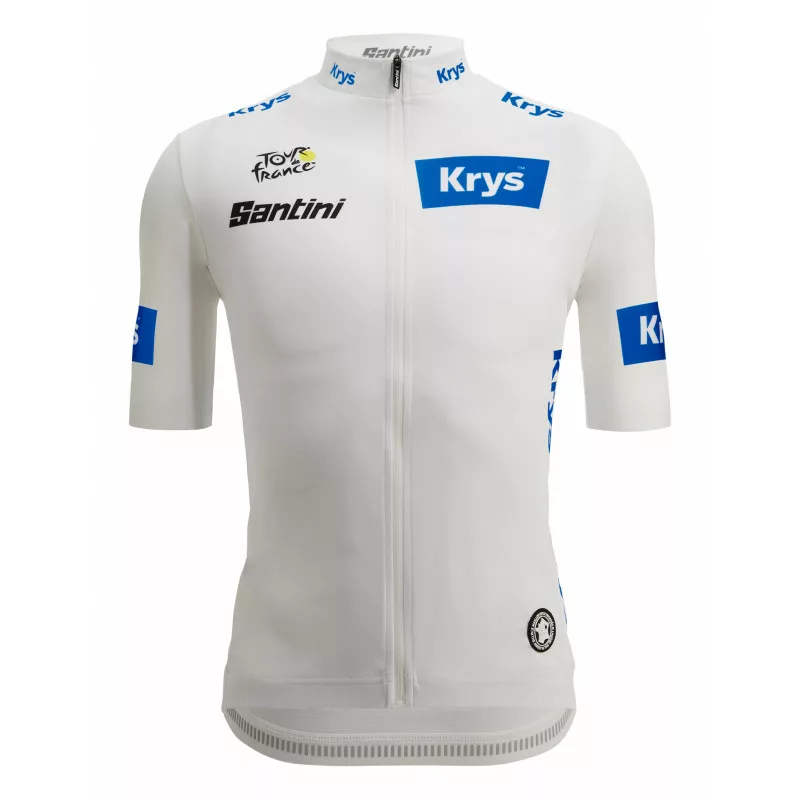
The white jersey: Maillot Blanc – The best young rider jersey
The white jersey, or Maillot Blanc, is a symbol of youthful talent and promise in the Tour de France. It is awarded to the best young rider under the age of 26, highlighting the emerging stars of the sport. The white jersey was also introduced in 1975 to recognise the impressive performances of young riders and provide them with a platform to shine.
The white jersey stands out with its clean and crisp design, representing the purity and potential of young riders. It serves as a reminder that the future of cycling lies in the hands of these talented individuals. The white jersey is often hotly contested, as young riders seize the opportunity to make their mark on the race and showcase their potential.
To win the white jersey, riders must demonstrate exceptional skill and consistency throughout the race. They compete not only against each other but also against more experienced riders, making their achievements even more impressive. The white jersey offers a glimpse into the future of the sport, celebrating the young riders who have the potential to become the next generation of cycling legends.
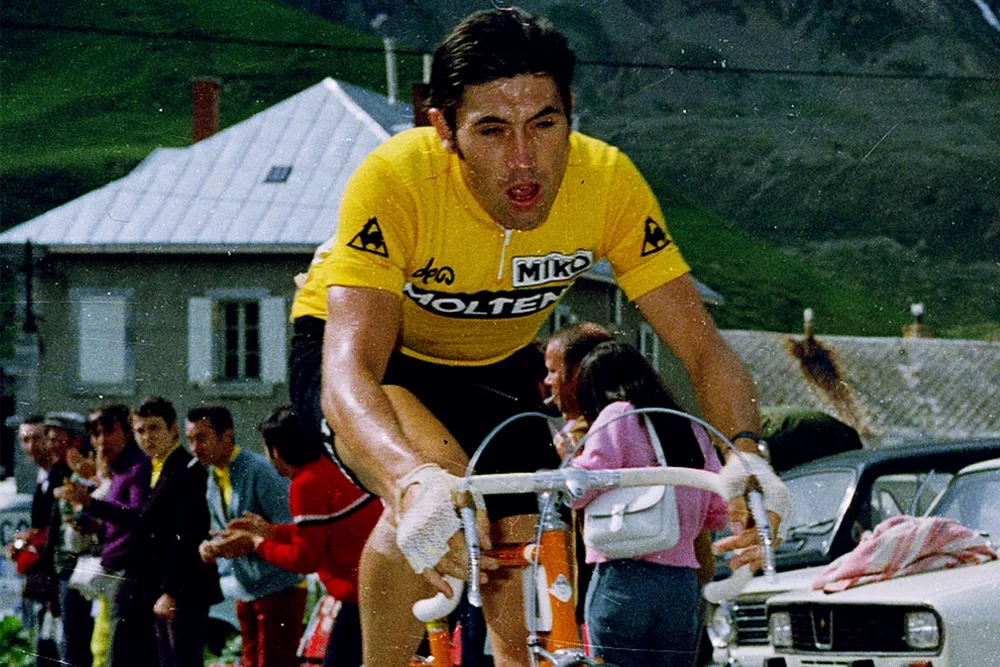
The history and significance of the jerseys
The jerseys of the Tour de France carry a rich history and deep significance that is intertwined with the race itself. Each jersey tells a story, representing different aspects of the sport and the extraordinary athletes who participate in it. From the inaugural yellow jersey that marked the birth of a tradition, to the green jersey that celebrates the explosive power of sprinters, these jerseys have become symbols of excellence and determination.
Over the years, the jerseys have evolved in design and style, reflecting the changing times and the advancements in sports fashion. What started as simple garments to distinguish the race leaders have transformed into works of art, with intricate patterns, bold colours, and sponsor logos adorning the fabric. The design choices are not arbitrary; they are carefully considered to capture the essence of each jersey and its respective category.
The jerseys have also witnessed the triumphs and tribulations of legendary riders who have left an indelible mark on the Tour de France. From Eddy Merckx ‘s dominance in the yellow jersey to Peter Sagan’s reign as the king of the green jersey, these riders have become synonymous with the jerseys they wore, etching their names into the annals of cycling history.
The significance of the jerseys extends beyond the race itself. They have become cultural icons, representing the spirit of competition, the pursuit of excellence, and the camaraderie among riders. Fans and collectors alike treasure these jerseys, displaying them as symbols of their love for the sport and the enduring legacy of the Tour de France.
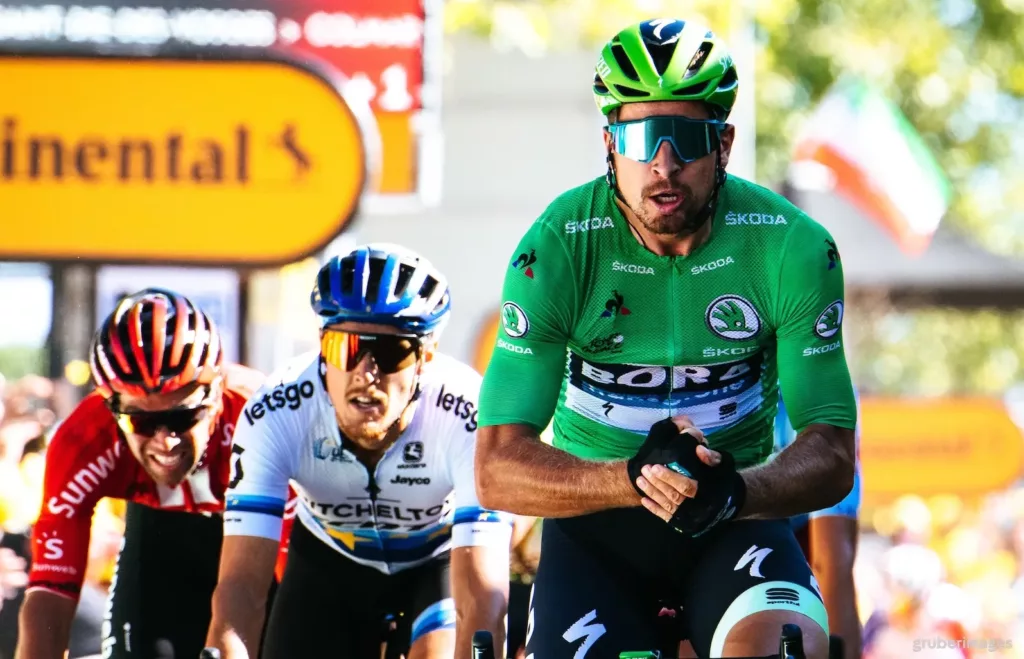
Famous riders who have dominated the jerseys
Throughout the history of the Tour de France, there have been riders who have dominated the different jerseys, leaving an indelible mark on the race. These riders have become legends in their own right, their achievements etched into the fabric of the jerseys they wore.
In the yellow jersey category, one cannot overlook the legendary Eddy Merckx. The Belgian cyclist won the yellow jersey a record-breaking five times and is considered one of the greatest riders in the history of the sport. Merckx’s dominance in the yellow jersey remains unparalleled, earning him the nickname “The Cannibal” for his insatiable hunger for victory.
In the green jersey category, Peter Sagan’s name shines bright. The Slovakian cyclist has won the green jersey a record-breaking seven times, showcasing his exceptional sprinting abilities and versatility as a rider. Sagan’s charismatic personality and thrilling performances have made him a fan favourite, and his reign as the king of the green jersey continues to captivate audiences around the world.
In the polka dot jersey category, Richard Virenque stands out as one of the most successful climbers in the history of the Tour de France. The French cyclist won the polka dot jersey a record-breaking seven times, showcasing his mastery of the mountains and his relentless pursuit of victory. Virenque’s tenacity and climbing prowess have made him a legend among fans of the race.
In the white jersey category, Jan Ullrich’s name holds a special place. The German cyclist won the white jersey three times and went on to become the overall winner of the Tour de France in 1997. Ullrich’s achievements at a young age marked him as a rising star in the sport, and his performances continue to inspire young riders to this day.
These riders, among many others, have left an indelible mark on the Tour de France jerseys, solidifying their status as legends of the race and inspiring future generations of cyclists.
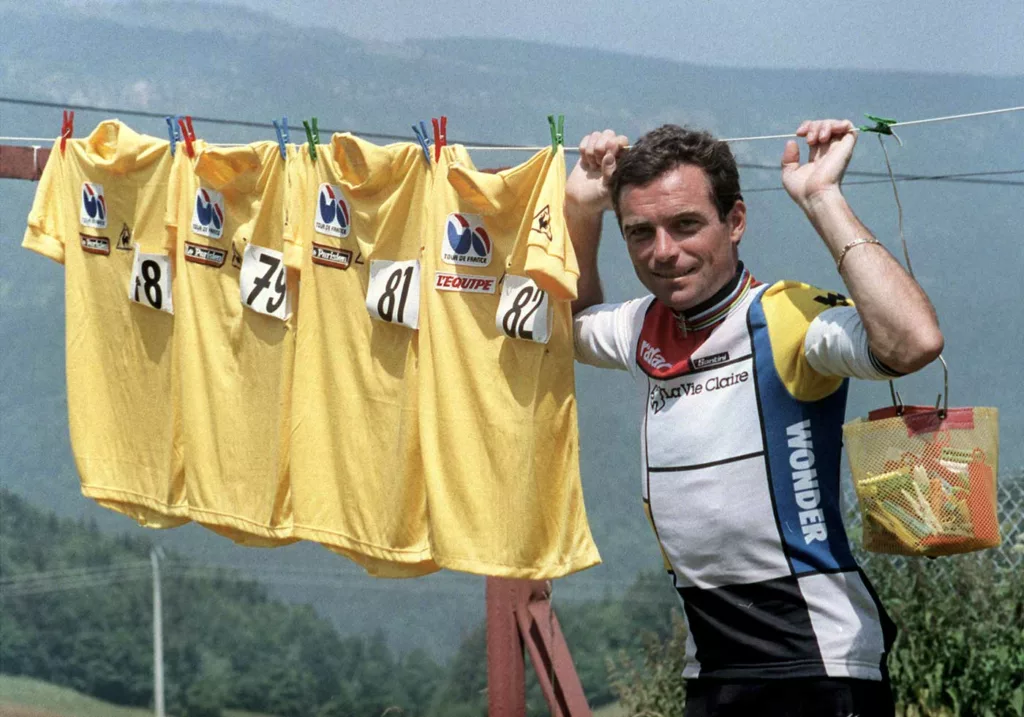

The evolution of the jerseys over the years
The jerseys of the Tour de France have undergone significant changes over the years, reflecting the evolution of both the sport and the fashion industry. What started as simple garments to distinguish the race leaders have transformed into highly sought-after fashion statements, capturing the attention of fans and designers alike.
In the early years of the Tour de France, the jerseys were basic and functional, with minimal design elements. The emphasis was on functionality rather than fashion, as the primary purpose of the jerseys was to identify the race leaders. The yellow jersey, for example, was a simple garment made of wool, featuring a collar, buttons, and short sleeves.
As the race gained popularity and sponsorship deals became more prominent, the jerseys started to incorporate sponsor logos and branding. This marked the beginning of the jerseys’ transformation into advertising billboards, with sponsors’ names and logos becoming prominent features of the design.
In recent years, advancements in fabric technology and printing techniques have allowed for more intricate and visually stunning designs. The jerseys now feature bold colours, intricate patterns, and eye-catching graphics, capturing the attention of fans and creating a sense of excitement around the race.
The evolution of the jerseys is not just limited to their design; the materials used have also undergone significant changes. Wool has been replaced by lightweight synthetic fabrics that offer enhanced breathability and moisture-wicking properties, ensuring that the riders stay cool and comfortable during the race.
The jerseys of the Tour de France are a testament to the ever-changing nature of fashion and the sport itself. They reflect the trends and innovations of their respective eras, serving as a visual timeline of the race’s history and the evolution of cycling attire.
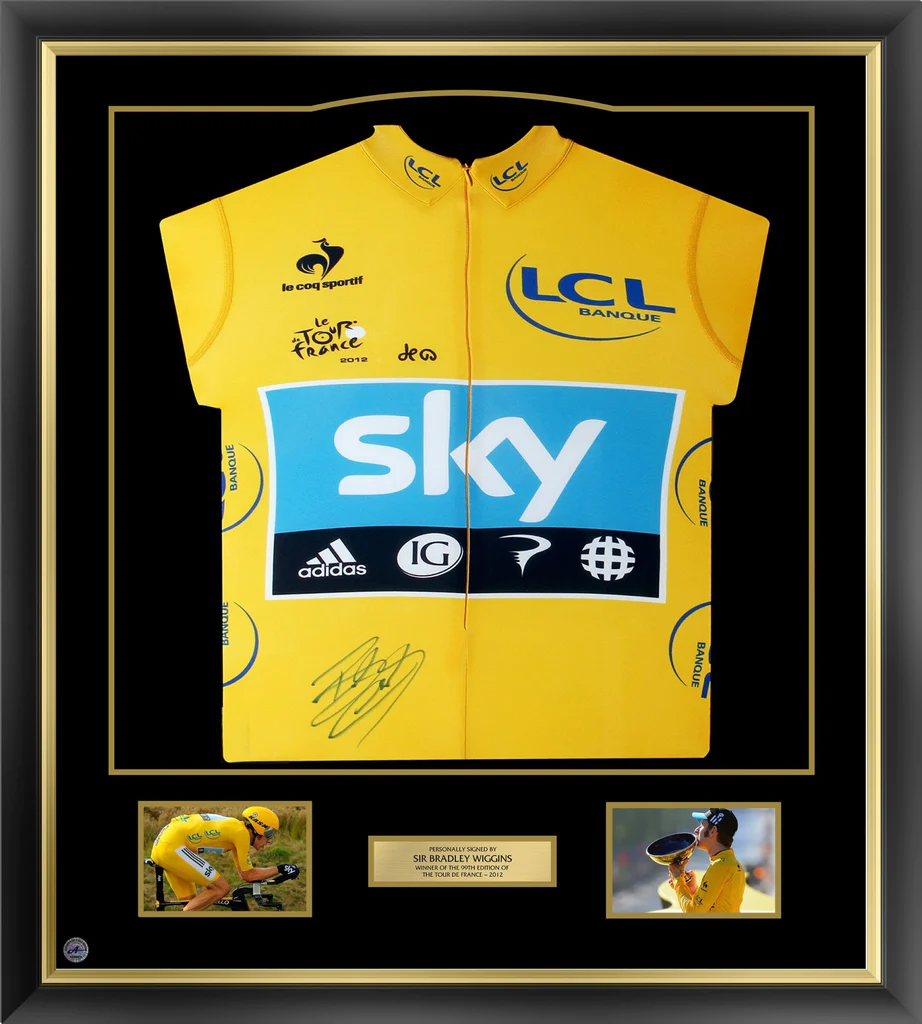
Collecting and displaying Tour de France jerseys
For fans of the Tour de France, collecting and displaying jerseys is a way to celebrate their love for the sport and the iconic race. Tour de France jerseys hold immense sentimental value, representing the history, achievements, and legends of the race. Here are a few tips for collecting and displaying these cherished garments.
Research and authenticity
When collecting Tour de France jerseys, it is important to research their authenticity. Look for official replicas or jerseys that have been verified by reputable sources. Be cautious of counterfeit jerseys that may be circulating in the market.
Focus on significance
Consider collecting jerseys that hold significance to you personally. Whether it’s the yellow jersey of your favourite rider or the polka dot jersey of a legendary climber, choose jerseys that resonate with you and tell a story.
Display with care
When displaying Tour de France jerseys, it is important to handle them with care. Use proper hangers or display cases to prevent creasing or damage to the fabric. Avoid exposing the jerseys to direct sunlight or excessive moisture, as this can cause fading or deterioration.
Tell the story
Accompany your displayed jerseys with information and stories about the riders or the race itself. This adds depth and context to the jerseys, allowing viewers to appreciate their significance and the history they represent.
Rotate your collection
If you have a substantial collection of Tour de France jerseys, consider rotating them periodically to keep the display fresh and interesting. This allows you to showcase different jerseys and riders while preserving the condition of each garment.
Collecting and displaying Tour de France jerseys is not just a hobby; it is a way to pay homage to the sport and the athletes who have made it legendary. It is a celebration of the rich history and captivating stories behind these iconic garments, allowing fans to immerse themselves in the vibrant world of cycling attire.
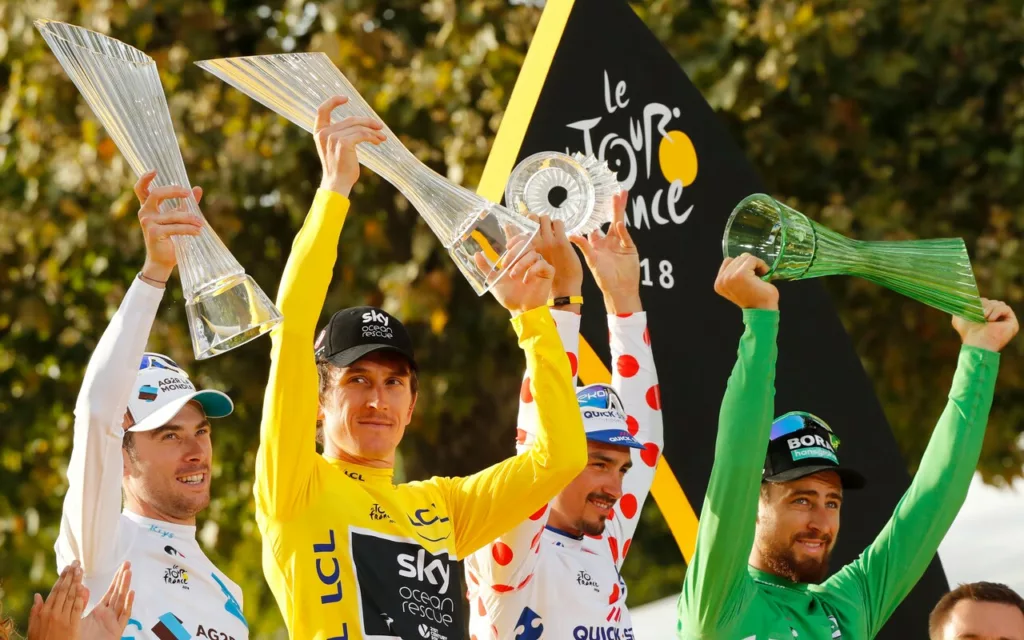
The Tour de France jerseys are more than just pieces of clothing; they are symbols of excellence, determination, and the indomitable spirit of the race. From the iconic yellow jersey that represents the leader to the polka dot jersey that honours the best climber, each jersey carries its own narrative and significance.
The jerseys of the Tour de France have evolved over the years, reflecting the changing times and the advancements in sports fashion. What started as simple garments to distinguish the race leaders have transformed into works of art, with intricate designs and bold colours capturing the attention of fans and designers alike.
Collecting and displaying Tour de France jerseys is a way to celebrate the sport and its legends. These jerseys hold immense sentimental value, representing the history, achievements, and legends of the race. They serve as a visual timeline of the Tour de France’s evolution and the enduring legacy of the athletes who have graced its stages.
So gear up and embark on this captivating journey through the vibrant world of cycling attire. Explore the secrets behind the yellow, green, polka dot, and white jerseys, and discover the stories that have shaped the Tour de France. Immerse yourself in the kaleidoscope of colours and symbolism that grace these iconic jerseys, and gain a newfound appreciation for the artistry woven into the fabric of the race. The Tour de France jerseys are not just garments; they are symbols of triumph, passion, and the enduring spirit of the race.
Related Posts
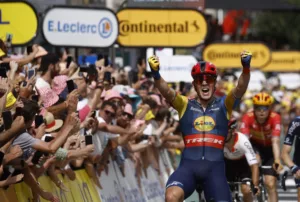

- OlympicTalk ,

- Dustin Long ,

Trending Teams
2023 tour de france jerseys: what do the yellow, green, white and polka dot jerseys mean.
The world’s greatest cyclists have their sights set on the Tour de France 2023 — and with the infamous event less than one month away, not much time remains until we see the best riders compete to obtain the yellow, green, polka-dot and white jerseys. But what do these highly coveted jerseys mean to the cyclists fighting for them?
The famed Tour de France is making its way to NBC and Peacock in just a few weeks, taking place Saturday, July 1 through Sunday, July 23. See below to learn what the Tour de France jerseys mean and how a rider earns one.
RELATED: Tour de France 2023: How to watch, start time, route and more
What is the meaning of the yellow jersey?
Nearly every professional cyclist dreams of someday donning the Tour de France’s yellow jersey, also known as the maillot jaune .
This piece of clothing that stands above all else is awarded to the overall classification leader at the conclusion of each stage, with the fastest rider from the day before given the right to wear the jersey for the following day of racing. It’s important to remember, however, that the winner of this jersey is based on time rather than points, so the winner of the stage is not always the cyclist who gets to bear the yellow jersey.
When the race is completed, the overall champion of the Champs-Élysées receives the fabled yellow jersey. Last year’s winner of the maillot jaune was Team Jumbo-Visma’s Jonas Vingegaard , who remains a favorite for this year’s Tour.
RELATED: Relive Jonas Vingegaard’s 2022 Tour de France victory
What is the meaning of the green jersey?
The green jersey, also known as the maillot vert, is awarded to each day’s leader in points classification. These points are distributed among riders at stage finishes and intermediate sprints in line stages.
The number of points available for each stage varies depending on the stage’s profile. For example, a flat stage finish is typically worth more points than a hilly or mountainous stage finish. The jersey is typically dubbed “the sprinter’s jersey”, and is seen as a symbol of passion and explosivity from the riders who wear it.
Belgian star Wout van Aert earned the maillot vert in fiery fashion last year, picking up 480 points throughout the Tour de France. The closest any rider came to matching this number was Jasper Philipsen , who earned 286.
What is the meaning of the polka-dot jersey?
The Tour de France’s polka-dot covered jersey ( maillot à pois rouges) is awarded to the “King of the Mountains”, the rider who leads the pack in Mountains Classification.
Points are distributed to riders who reach the summit first in designated climbs of each stage. These, points, however, can vary depending on the difficulty of the climb. These climbs are ranked in categories 1 through 4, with 1 being the most difficult and 4 being the least. If a climb is ranked as “ hors catégorie”, it means that this is a climb “beyond category”, reserved for the most challenging endeavors. Points are then awarded based on the category of the climb.
A rider who earns the maillot à pois rouges symbolizes one who pushes beyond their limits with a great deal of courage. In addition to claiming the yellow jersey in 2022, Jonas Vingegaard also claimed last year’s polka-dot jersey, being crowned “King of the Mountains”.
RELATED: Click here for all NBC Sports cycling coverage
What is the meaning of the white jersey?
The white jersey ( maillot blanc) is one of promise and hope for the future. While the jersey first surfaced on the Tour in 1968 to reward the leader of combined classification, its meaning transformed in 1975 to a recognition of cycling’s young achievers.
Today, the white jersey remains as a symbol of youthful talent, being awarded to the best placed cyclist in overall standings under the age of 26. Slovenia’s Tadej Pogacar earned rights to the maillot blanc in last year’s Tour de France at 23 years old.
When is the 2023 Tour de France?
The 2023 Tour de France will take place from July 1-23. The riders will embark on the first stage in Bilbao on Saturday, July 1.
How can I watch the 2023 Tour de France?
Coverage will air on NBC Sports and Peacock from start to finish.
Be sure to follow OlympicTalk for the latest news, storylines, and updates on the 2023 Tour de France!
2-FOR-1 GA TICKETS WITH OUTSIDE+
Don’t miss Thundercat, Fleet Foxes, and more at the Outside Festival.
GET TICKETS
BEST WEEK EVER
Try out unlimited access with 7 days of Outside+ for free.
Start Your Free Trial
Powered by Outside
Tour de France
What do the tour de france jerseys mean, the tour de france is a colorful affair, with multiple competitions going on simultaneously. the leader of each competition wears a special yellow, white, green, or polka-dot jersey..
Heading out the door? Read this article on the new Outside+ app available now on iOS devices for members! >","name":"in-content-cta","type":"link"}}'>Download the app .
The Tour de France is a stage race, which is a multi-day competition consisting of individual races — or stages — where prizes are awarded for both each day’s competition and for the cumulative overall results.
The primary competition is time-based: The first man across the line each day wins the stage. But the biggest battle at the Tour is for the yellow jersey: The rider with the lowest time overall after the 21 stages wins the Tour de France.
- 2022 Tour de France essential race preview: Who will win the yellow jersey?
- Tour de France 2022: Frequently asked questions
- How to watch the 2022 Tour de France: Online, streaming, and on television
There are races within the race: The King of the Mountains competition, the Points competition — often referred to as the sprinter’s jersey — and the Best Young Rider competition. As with the overall race lead, the leader of each of these competitions wears a special jersey throughout the race.
The Tour de France is a grand tour, which is the most prestigious type of stage race in the world and lasts for three weeks. The Giro d’Italia in Italy and the Vuelta a España in Spain are the other two grand tours. The Giro and the Vuelta have similar jersey competitions, but with different colored jerseys.
Here is what the colored jerseys of the Tour de France mean.
Yellow (General Classification)
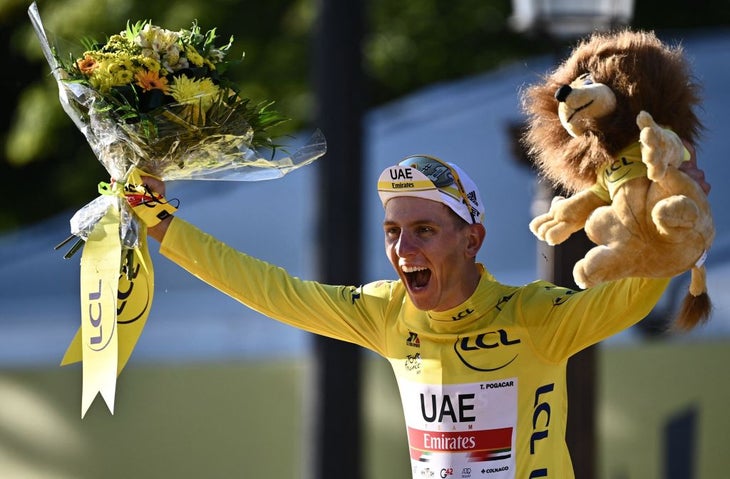
After each stage, the rider with the fastest cumulative time is awarded the yellow race leader’s jersey to wear the following day. The cumulative time is what is known as the general classification, as opposed to each day’s stage result. While it is prestigious to wear the yellow jersey on any stage, it is only the final, cumulative result after three weeks that wins one rider the Tour de France — and €500,000 in prize money. The other podium finishers also ride away with a decent financial bonus with €250,000 going to the runner-up and €125,000 for third place.
Polka-dot (King of the Mountains)
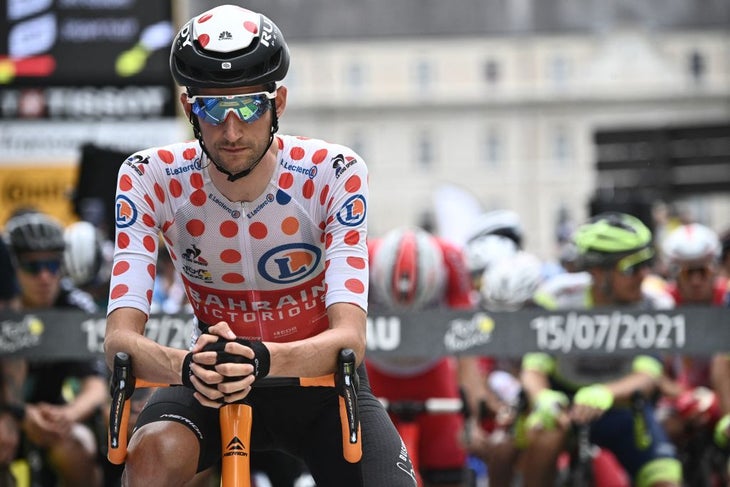
Mountain points are awarded at the summit of all categorized climbs. The rider with the most cumulative mountain points wears the polka-dot jersey throughout the race. The overall winner earns €25,000 in prize money.
Points in the competition are graded by the severity of the climbs, with the tough ascents offering up the most points. Climbs that are deemed hors catégorie, or beyond categorization, are the hardest, and fourth category ascents are the easiest. Crossing the line first on an hors catégorie climb can earn a rider 20 points down to two for eighth across the line, while a fourth category only offers one point for the first rider.
Green (Points competition)
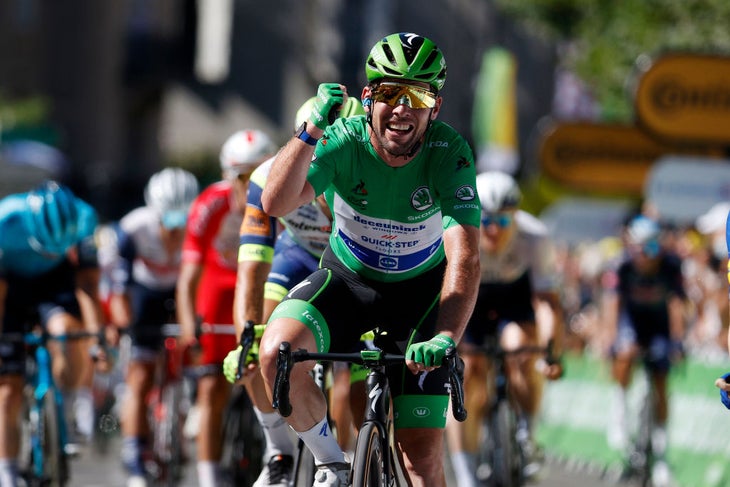
Points are awarded each stage (other than individual time trials) at intermediate sprints and at the end of every stage finish. The rider with the most points wears a green jersey, and the rider who finishes with the most points takes green and €25,000 in prize money.
How the points are allocated has been altered over the years with much more weight given to the flat sprint days in recent years. Currently, riders get 50 points for a win on a flat day compared to 30 on a hilly stage and 20 when the race goes through the high mountains. As well as at the finish, there are points on offer in the intermediate sprints, the allocation of which remains the same each day.
Peter Sagan has the record for number of green jersey’s won after claiming his seventh in 2019, while Erik Zabel was the previous record holder at six.
White (Best young rider)
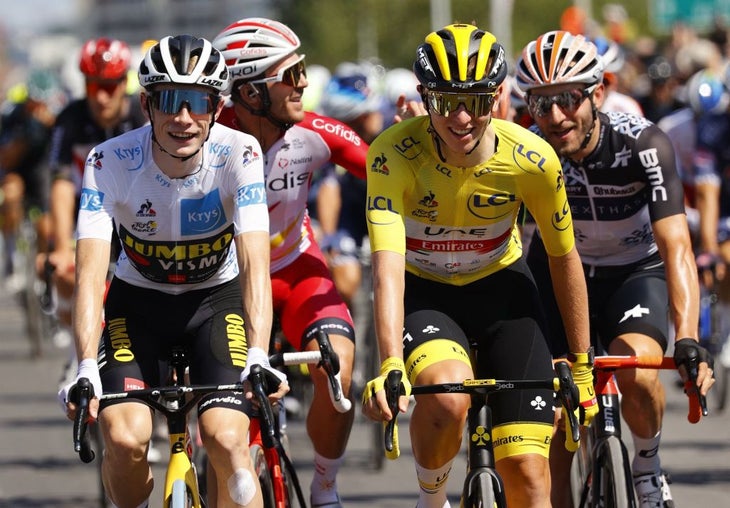
The rider with the fastest cumulative time who is 25 or younger wears the white jersey. The overall winner earns €20,000 in prize money. It was introduced in 1975 and many riders that have won this jersey have gone on to win the Tour de France outright, and in recent years, the yellow jersey has been the winner of the youth classification as well.
Two-time winner Tadej Pogačar and 2019 victor Egan Bernal were both under 25 when they took the overall win.
Other prizes and symbols at the Tour de France
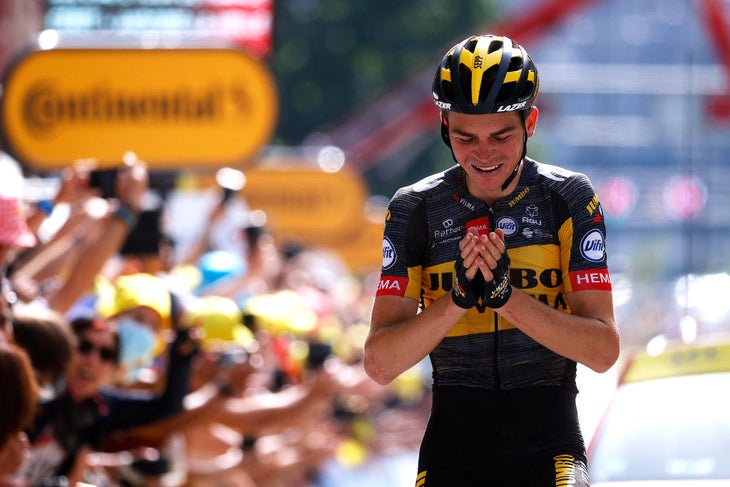
Winning a stage of the Tour de France represents a career-affirming accomplishment for a pro cyclist. Every year there are 21 stages up for grabs, and each one pays €11,000 to the winner.
Combativity prize
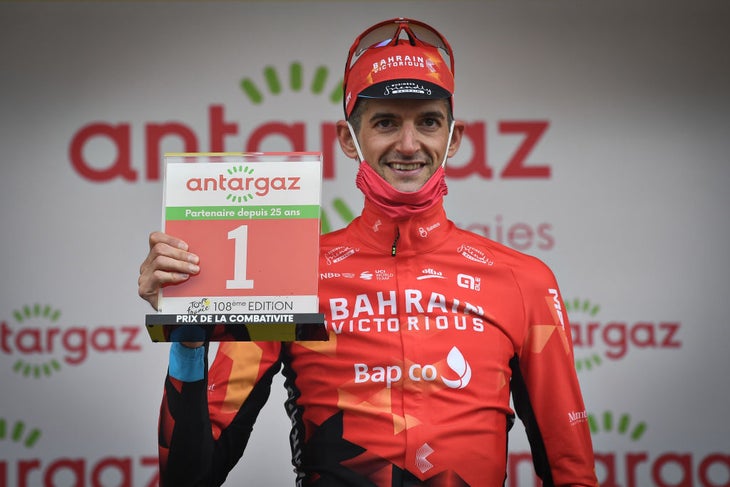
A panel of experts picks the most aggressive rider during each stage; this rider wears a white number with a red background on his jersey the next day and earns €2,000. At the end of the race, the panel will award one rider with the “Super Combativity” prize and €20,000.
Team Classification
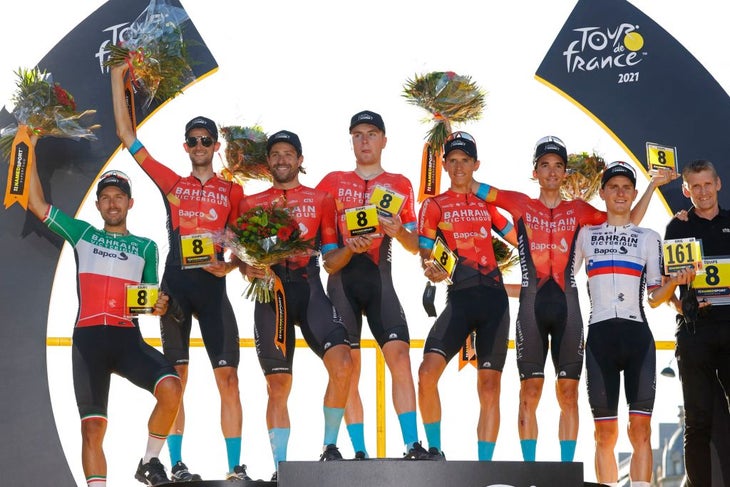
After each stage, the cumulative times of the three best-placed riders on each team are tallied, excluding any time bonuses or penalties. The team with the lowest cumulative time at the end of the race wins the Team Classification and €50,000.
Popular on Velo
>", "path": "https://velo.outsideonline.com/road/road-racing/geraint-thomas-better-than-last-year-and-bullish-for-giro-tour-double-at-tour-of-the-alps-tune-up/", "listing_type": "recirc", "location": "list", "title": "geraint thomas ‘better than last year’ and bullish for giro-tour double at tour of the alps tune-up"}}'> geraint thomas ‘better than last year’ and bullish for giro-tour double at tour of the alps tune-up, >", "path": "https://velo.outsideonline.com/road/road-racing/the-races-that-are-best-for-me-are-over-mathieu-van-der-poel-on-underwhelming-amstel-gold-performance/", "listing_type": "recirc", "location": "list", "title": "‘the races that are best for me are over’: mathieu van der poel on underwhelming amstel gold performance"}}'> ‘the races that are best for me are over’: mathieu van der poel on underwhelming amstel gold performance, >", "path": "https://velo.outsideonline.com/road/road-racing/lorena-wiebes-rues-celebration-slip-up-i-will-lose-some-sleep-on-that-one/", "listing_type": "recirc", "location": "list", "title": "lorena wiebes rues celebration slip-up: ‘i will lose some sleep on that one’"}}'> lorena wiebes rues celebration slip-up: ‘i will lose some sleep on that one’, >", "path": "https://velo.outsideonline.com/road/road-racing/tom-pidcock-grabs-dramatic-amstel-gold-race-in-four-man-sprint/", "listing_type": "recirc", "location": "list", "title": "tom pidcock grabs dramatic amstel gold race in four-man sprint"}}'> tom pidcock grabs dramatic amstel gold race in four-man sprint.
9 Things to See in Moscow's Red Square
Sir Francis Canker/Getty Images
In most cases, you'll be entering Red Square from the north, passing landmarks such as the Bolshoi Theatre and Duma parliament building as you make your way southward. Although you don't necessarily have to pass through the Voskresensky (or Resurrection in English) Gates in order to gain access to the square these days, they definitely provide a sense of arrival, to say nothing of the way their left arch frame's St. Basil's Cathedral if you look from just the right angle.
An interesting fact is that while a gate of some kind has stood here since the mid-16th century, the one you currently see wasn't built until 1994, having been destroyed in 1931 so that tanks could enter and exit Red Square during military parades.
St. Basil's Cathedral
TripSavvy / Christopher Larson
Few sights are as iconic not only of Moscow and Red Square but indeed of Russia than St. Basil's Cathedral, whose colorful, onion-shaped domes are a symbol of the country around the world. Officially known as the Cathedral of Vasily the Blessed, this church has stood since 1561, which is quite miraculous when you consider all the turbulent history that has transpired since then.
Among other things, religion was severely prohibited during the Soviet period , which led some to believe that this emblem of the Russian Orthodox church might not withstand the tenure of the USSR.
An interesting fact is that St. Basil's is the so-called "Kilometer Zero" of Russia; all of Moscow's main roads (which can take you anywhere in Russia) begin at the exits to Red Square. In this way, St. Basil's iconic status also has an extremely tangible element.
The Kremlin
TripSavvy / Christopher Larson
When you think of The Kremlin, it's unlikely that positive images enter your mind. The fact that simply saying the word "Kremlin" is too vague a descriptor (most Russian cities have their own Kremlin complexes; you should say "Moscow Kremlin") notwithstanding, this misunderstood place is incredibly beautiful, even if you don't like the policy that comes out of it.
Senate Square
In spite of its name, which refers to the role the building that rises above the square played during Imperial Russia, Senate Square is actually home to Russia's presidential administration, currently helmed by Vladimir Putin. In order to see where Russia's legislature operates from, walk just outside Red Square to the Duma parliament building.
Dormition Cathedral
Dating back to the year 1479, the gold-domed Dormition Cathedral pays homage to an Orthodox religious feast that commemorates the death of the Virgin Mary . As is the case with St. Basil's, it is curious that such a conspicuously religious structure was able to survive through the Soviet period.
Armoury Chamber
Though it takes its name from the fact that it housed Russia's royal arsenal when it was built in the 16th century, the most notable resident of the Kremlin's Armoury Chamber today is the Russian Diamond Fund.
Notable Kremlin Towers
Robert Schrader
The interior of the Moscow Kremlin is more beautiful and inviting than you'd expect, but the walls and towers that rise around it better live up to the intimidation with which the complex is associated.
Borovitskaya Tower
Named to commemorate the dense forest that once stood atop the mount where it's built, this tower is extremely picturesque. Built in the late 15th century, it's visible from most places in the square, and also as you walk along the Moskva River.
Nikolskaya Tower
Also built in the year 1491, this tower currently suffered destruction at the hands of Napoleon's army in the 19th century. What you see now is the result of an 1816 re-design and renovation, though artillery fire during the Russian Revolution also caused superficial damage to the tower, named to honor St. Nikolas of Mozhaysk , so it's difficult to know which elements of it are original.
Spasskaya Tower
Known in English as the "Savior's Tower," this iconic, star-topped tower is perhaps the best-known of all the Kremlin's towers. Built in 1491 like the other two towers on this list, it's certainly the most photographed. As a result of its proximity to St. Basil's, it often makes its way into tourists' pictures.
Mausoleum of Lenin
Just as it's strange to learn how many religious monuments survived through the Soviet period, it's a bit odd to think that Lenin's preserved body still sits in a mausoleum just beneath the walls of the Kremlin on Red Square, given the lack of consensus about the ultimate impact of his Revolution, even in Russia.
It's not guaranteed that you'll be able to see the body (which, believe it or not, seems to be improving with age ) when you go, and if you do you will likely have to wait in line, but even strolling past the outside of the Lenin Mausoleum, flanked by stone-faced guards that almost look like statues, illuminates the gravity of his body still being here.
GUM Shopping Center
You might cringe, at least initially, when you realize that one of the most iconic stops on a tour of Red Square is a department store—until you see said department store, that is. Built in 1893 and known during Soviet times as the State Department Store, GUM ( Glávnyj Universáľnyj Magazín or Main Universal Store in English) hearkens back to the grandeur of the late 19th century, both seen from the outside (especially, when lit up at night) and the interior, which might have you feeling like you're further west in Europe.
A trip inside GUM is a particularly good idea during winter, when frigid temperatures outside will have you savoring the heat, the quality of souvenirs, confections and other goods sold inside notwithstanding. Also, make sure not to confuse GUM with CDM, which sits near the Bolshoi Theatre, even though both are stunning and iconic in their own right.
State Historical Museum
The Russian State Historical Museum is located near Voskresensky Gates, though you should wait until after you've seen the first few attractions of Red Square and the Kremlin to head back there and go inside. To be sure, as you pass by its facade (whose late-19th century grandeur somewhat obscures that fact that it's currently a museum accessible to the public) you might not even think to try and gain entry.
Once inside the museum, you can plan to spend at least a couple of hours, given that artifacts here date back to the very beginning of the Russian state in the ninth century. As is the case with GUM, this will be a particularly alluring prospect if you visit in winter, when Moscow is arguably at its most beautiful, but certainly at its least tolerable.
Minin-Pozharsky Monument
It's somewhat easy to disregard this monument, which pays homage to the two Russian princes who ended the so-called "Time of Troubles" in the mid-16th century, during which Polish-Lithuanian forces occupied Russia, among other awful things including a famine. That's because the statue currently sits just at the base of St. Basil's Cathedral, which makes it very difficult to photograph or even see without being overwhelmed by that much more famous edifice.
Though the statue originally sat at the very center of Red Square, it came to be an obstacle to the movement of tanks during the Soviet period, much like the Voskresensky Gates. As a result, authorities moved it during that time, and it's stayed where you currently find it ever since.
Kazan Cathedral
Taken by itself, the smokey-pink Kazan Cathedral is an architectural marvel; originally built in the 17th century, the church you find here today, located just north of the GUM department store, dates back only to 1993.
Unfortunately, since it sits not only in the shadow of GUM, but also in the shadow St. Basil's and the Towers of the Kremlin, it's easy to miss entirely if you aren't looking. As a result, you might wait until you've seen just about everything else in Red Square before coming here to take photos, and to appreciate the understated beauty of this oft-overlooked cathedral.
Moskva River
As you head south from St. Basil's Cathedral to exit Red Square, make sure to walk onto Bolshoy Moskvoretskiy Bridge, which crosses the Moskva River. If you look due north, you can get an excellent shot of the church framed, on the left, by the towers of the Kremlin. Directing your gaze a bit to the west allows you to see the skyscrapers of Moscow City as they rise above the Kremlin's walls.
Walking westward along the riverbank is also a worthwhile excursion, for the views it provides of Red Square and the Kremlin, as well as the fact that doing so takes you to other iconic Moscow attractions, including Gorky Park and the Pushkin Museum. The views you enjoy from the river and the bridge are particularly stunning at night, though you should make sure you bring a tripod if you want to get a clear picture, given how strong winds over and near the river can be.
Moscow - Russian Rivers and Waterways Port of Call
Moscow Metro: The Complete Guide
25 Best Things to Do in Moscow
The Impressive Castles of Eastern Europe
St. Basil’s Cathedral in Moscow: Planning Your Visit
St. Petersburg, Russia
10 Must-Visit Palaces and Castles in Russia
Top 12 Things to Do in Kazan, Russia
The Top 12 Things to Do in Nizhny Novgorod, Russia
The Top 12 Things to Do in Astrakhan
Soviet Sights in Moscow – Moscow USSR Sites
A Guide to the 4th Arrondissement in Paris
The Top 15 Places to Visit in Russia
The Top 12 Things to Do in Novgorod, Russia
The Top 15 Things to Do in Bordeaux, France
A Guide to Moscow: Capital of Russia, City of Domes

IMAGES
COMMENTS
Points. Polka dots. Mountains. White. Best young rider. The Tour de France sees the very best cyclists in the world battle it out for the yellow, green, white and polka dot jerseys, based on the ...
FOUR JERSEYS FOR FOUR MEN. For the first time since 2018, the four distinctive jerseys of the Tour de France went to four different riders. Every stage of the 2023 edition shaped the battles that put Jonas Vingegaard in yellow, Tadej Pogačar in white —for the very last time—, Jasper Philipsen in green and Giulio Ciccone in the polka dots.
Official Tour de France merchandise and gear is at Le Tour De France Official Online Store UK. Shop Tour de France jerseys, shirts and Tour de France clothing to watch the prestigious race in style.
Santini Cycling Wear and A.S.O. are delighted to announce a new agreement making the Italian brand official partner to the Tour de France from 2022 to supply the prestigious Yellow Jersey and the other official jerseys for the elite multi-stage road race. The sponsorship deal also includes the Tour de France Femmes avec Zwift and L'Étape du ...
The yellow jersey is worn by the leader of the general classification, the rider with the lowest net time in the race after every stage. The rider who takes it to Paris is crowned the Tour de ...
Shop Tour de France men's apparel and clothing at Le Tour De France Official Online Store EU. Guys, gear up with Tour de France men's jerseys, shirts and clothing from Le Tour De France Official Online Store EU today.
Tour de France climbs are ranked from category 1 (most difficult) to category 4 (least difficult). A fifth class, hors catégorie ("beyond category"), is reserved for the most challenging ascents.
Tour de France 2023 Replica Team Jersey by Santini - Yellow. US$11300.
Tour de France 2023 Authentic Team Jersey by Santini - Green. Almost Gone! Reduced: US$4200. Regular: US$6900.
The symbol of the Tour de France, the yellow jersey, sponsored by LCL, is worn every day by the leader of the general individual classification and bestowed on the overall winner on the Champs-Élysées.A symbol of excellence, prestige and victory, the yellow jersey is beyond the reach of all but the most well-rounded riders —those who can hold their own on the plains, in the mountains and ...
The yellow jersey, or Maillot Jaune, is undoubtedly the most iconic and coveted jersey in the Tour de France. Worn by the overall leader of the race, it signifies their dominance and command over the peloton. The history of the yellow jersey dates back to 1919 when it was introduced as a way to easily identify the race leader.
Tour de France 2022 Authentic Team Jersey by Santini - Green. US$9700.
The Tour de France's Maillot Jaune ("Yellow Jersey") is awarded to the overall race leader at the end of each day, to be worn on the following stage. Despite the global fame of the yellow jersey as the icon of cycling greatness, its origins are surprisingly murky. In the early years of the Tour de France following its birth in 1903, the ...
Today, the white jersey remains as a symbol of youthful talent, being awarded to the best placed cyclist in overall standings under the age of 26. Slovenia's Tadej Pogacar earned rights to the maillot blanc in last year's Tour de France at 23 years old. When is the 2023 Tour de France? The 2023 Tour de France will take place from July 1-23.
Shop Tour de France men's apparel and clothing at Le Tour De France Official Online Store ROW. Guys, gear up with Tour de France men's jerseys, shirts and clothing from Le Tour De France Official Online Store ROW today.
Official Tour de France merchandise and gear is at Le Tour De France Official Online Store ROW. Shop Tour de France jerseys, shirts and Tour de France clothing to watch the prestigious race in style.
The Tour de France is a stage race, which is a multi-day competition consisting of individual races — or stages — where prizes are awarded for both each day's competition and for the cumulative overall results.. The primary competition is time-based: The first man across the line each day wins the stage. But the biggest battle at the Tour is for the yellow jersey: The rider with the ...
St. Basil's Cathedral. Few sights are as iconic not only of Moscow and Red Square but indeed of Russia than St. Basil's Cathedral, whose colorful, onion-shaped domes are a symbol of the country around the world. Officially known as the Cathedral of Vasily the Blessed, this church has stood since 1561, which is quite miraculous when you consider ...
Regular: US$13200. Tour de France Femme 2023 Tourmalet Jersey by Santini. Almost Gone! US$9435 with code. Regular: US$11100. Tour de France 2023 Replica Trionfo Team Jersey La Grande Boucle by Santini. 1. Tour de France jerseys are stocked at Le Tour De France Official Online Store ROW. Shop officially licensed Le Tour de France jerseys and ...
🎧 Wear headphones for the best experience.In this video, we will walk along the famous tourist routes of Moscow, take a walk along the renovated embankments...
🎧 Wear headphones for the best experience.In this video, we will walk through the beautiful streets of old Moscow, as well as visit some new districs.Moscow...